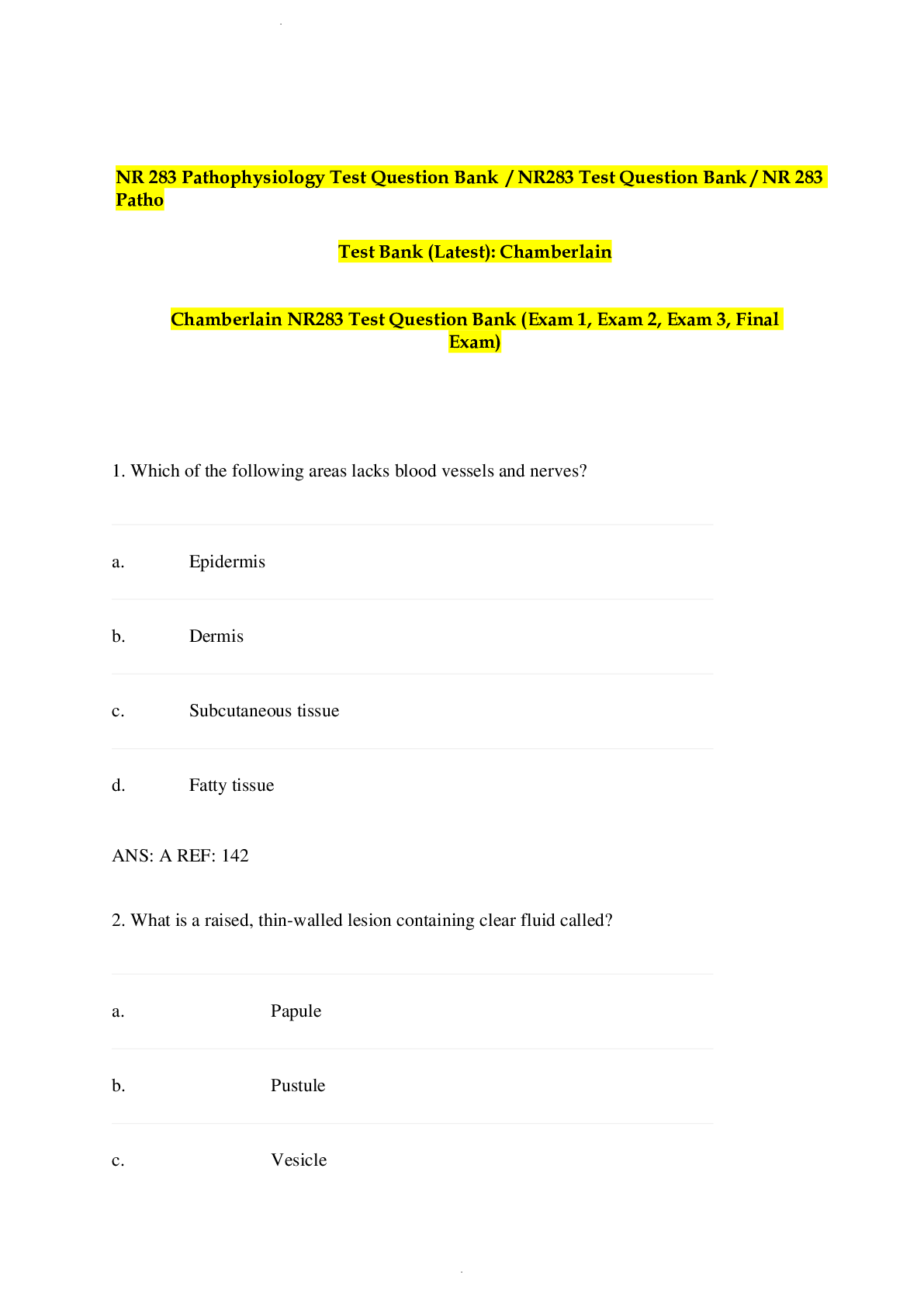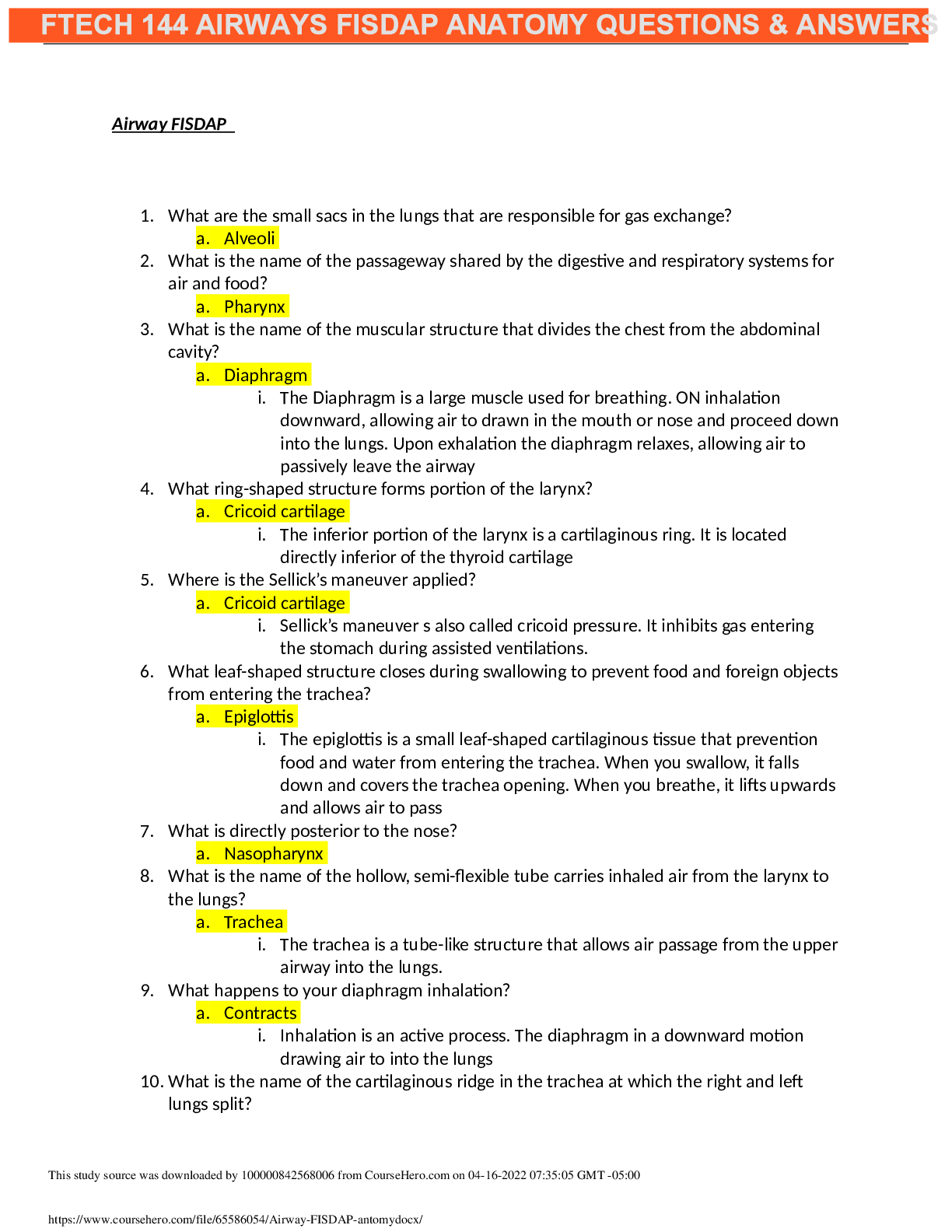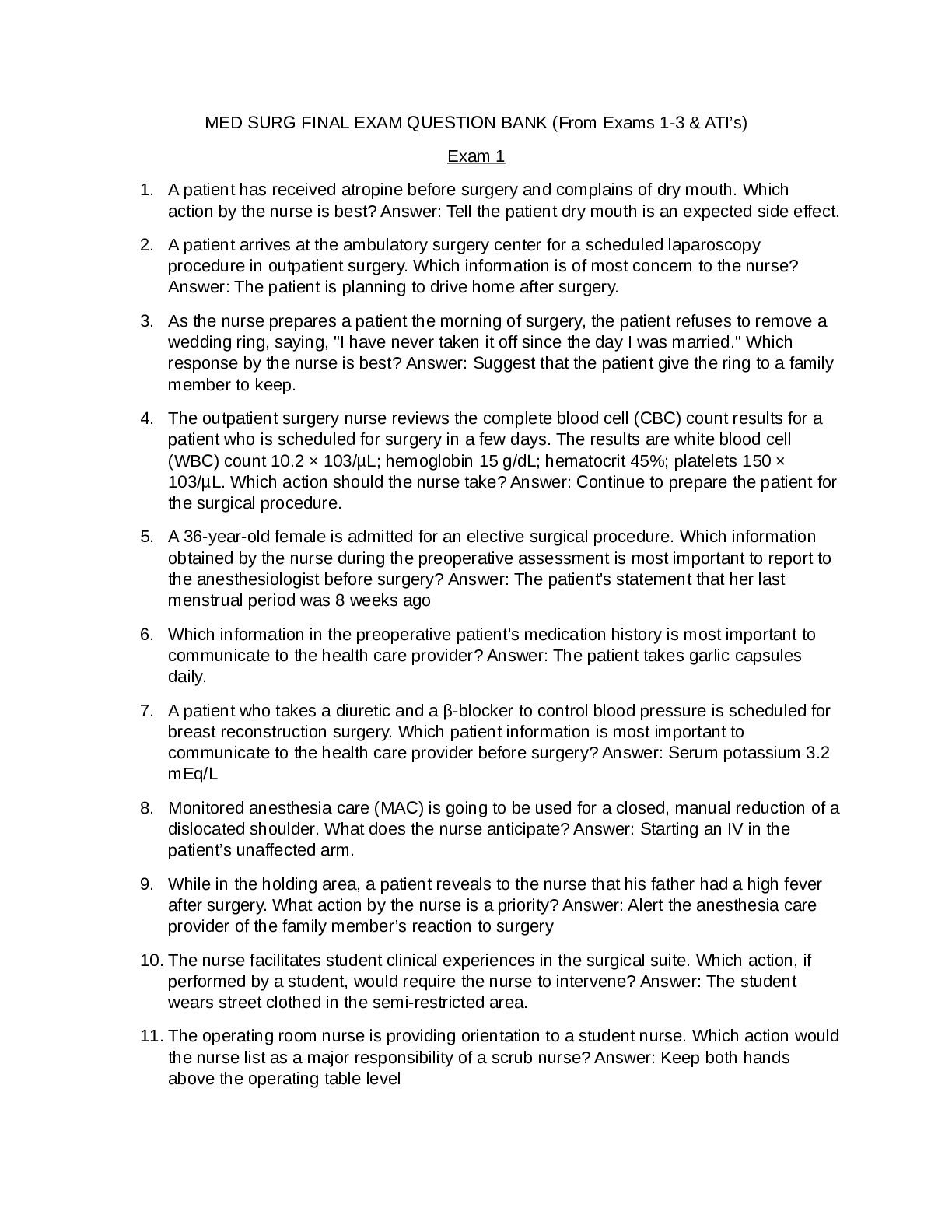Health Care > EXAM > NBME EXAM Question Bank ( Latest Exam Questions & Answers) All Answered (All)
NBME EXAM Question Bank ( Latest Exam Questions & Answers) All Answered
Document Content and Description Below
NBME EXAM Question Bank ( Latest Exam Questions & Answers) All Answered-A 67-year-old woman is hospitalized because of abdominal pain and persistent copious vomiting for 24 hours. Two weeks ago, she w... as hospitalized for treatment of atrial fibrillation; after cardioversion to a normal sinus rhythm, she began treatment with warfarin. Yesterday, at a follow-up visit, her INR was 6 (?? normal), and her medication was discontinued. She takes no other medications. Her temperature is 37°C (98.6°F), pulse is 120/min and regular, respirations are 20/min, and blood pressure is 100/78 mm Hg. The abdomen is distended and moderately tender; there is voluntary guarding in the epigastrium (??? source of pain) There are no masses, organomegaly, or obvious hernias. Rectal examination shows no abnormalities. Test of the stool for occult blood is negative. Her hemoglobin concentration has decreased from 13 g/dL yesterday to 7.8 g/dL today. An ECG shows a normal sinus rhythm. Which of the following is th - Intramural hematoma of the proximal small bowel A 4-year-old boy is brought to the physician by his parents because of fatigue and irritability over the past 2 months. The family visited relatives in rural Louisiana 5 months ago where the patient ran around barefoot. The child is active and appears normal. The conjunctivae are pale. Laboratory studies include a normal leukocyte count with 15% eosinophils. A stool preparation discloses the parasite egg shown. Which of the following is the most likely cause of fatigue and irritability in this patient? - Microcytic anemia Two days after beginning primaquine for malaria prophylaxis, a 17-year-old African American boy is brought to the physician because of dark urine and yellowing of his eyes. His pulse is 88/min, respirations are 12/min, and blood pressure is 124/68 mm Hg. Examination shows scleral icterus and pale mucous membranes. His hemoglobin concentration is 10 g/dL. A blood smear shows erythrocyte fragments and Heinz bodies. Which of the following is the most likely explanation for these findings? - Deficiency of glucose 6-phosphate dehydrogenase A one-day-old newborn male is found to have hemolytic disease of the newborn. Both parents are Rh-positive, mother is positive for IgG isohemagglutinins, while father is negative. Which of the following parental blood types most likely caused this condition? - Mother: O and Father: AB One week after receiving 4 units of packed red blood cells for acute hemorrhage due to a gunshot wound, a 17-year-old male develops fatigue, jaundice. Laboratory results show the following:Hemoglobin 8.8 g/dL Hematocrit 28%, Serum total bilirubin 5 mg/dL Serum lactate dehydrogenase 120 U/L. Liver and kidney function tests are otherwise within normal limits. Which of the following is the most appropriate next step in diagnosis? - Direct and indirect antiglobulin (Coombs) tests A 6-month-old boy is brought to the physician because of left knee swelling for 24 hours. Three months ago, he had three large hematomas on his forehead that resolved without treatment (??). His two sisters and his mother have no history of similar symptoms. His mother's maternal uncle and her brother died (x-linked recessive) before the age of 30 years of massive cerebral hemorrhages. Physical examination shows deep ecchymosis over the buttocks and severe swelling of the left knee. The most likely explanation for these findings is a deficiency of which of the following? - Factor VIII (antihemophilic factor) Three days after undergoing elective laparoscopic cholecystectomy for cholelithiasis, a 42-year-old woman has the onset of hematomas at all surgical sites. She was treated for deep venous thrombosis 3 years ago but was not taking any medications at the time of this admission. Results of preoperative laboratory studies were within the reference range. Prior to the operation, she received heparin and underwent application of compression stockings. Her initial postoperative course was uncomplicated. Heronly medication is ibuprofen. She is 163 cm (5 ft 4 in) tall and weighs 87 kg (192 lb); BMI is 33 kg/m2. Her temperature is 37.3°C(99.2°F), pulse is 94/min, respirations are 16/min, and blood pressure is 112/74 mm Hg. Examination shows mild hematomas at all surgical sites. The abdomen is soft and nontender. There is no organomegaly. Bowel sounds are normal. Laboratory studies show:Hemoglobin 10.3 g/dL Hematocrit 30%Leuk - Heparin-induced thrombocytopenia A 3-year-old girl with Down syndrome is brought to the physician because of a 1-week history of frequent nosebleeds, decreased appetite, and lethargy. She takes no medications. Her temperature is 38°C (100.4°F), pulse is 100/min, respirations are 20/min,and blood pressure is 80/45 mm Hg. Examination shows no other abnormalities except for pallor. Laboratory studies show:Hemoglobin 6.5 g/dL Hematocrit 19%Leukocyte count 100,000/mm3 Segmented neutrophils 15%Atypical lymphocytes 85%Platelet count 45,000/mm3 Which of the following is the most likely mechanism of these laboratory findings? - Infiltration of bone marrow by leukemic blasts A 30-year-old woman, gravida 2, para 1, comes for her first prenatal visit at 26 weeks' gestation. Uterine size is greater than expected for dates. Ultrasonography shows fetal hydrops. Which of the following is the most appropriate next step in diagnosis? - Maternal Rh status with antibody screening A 65-year-old man has had increasingly severe headaches and diffuse muscle aches during the past 3 months. He also has a 1-month history of jaw pain when chewing food and decreasing visual acuity in his left eye. His temperature is 38°C (100.4°F). Visual acuity in his left eye is 20/100, and the left optic disc is slightly atrophic. His muscle strength is normal. Which of the following tests should be obtained next? - Measurement of erythrocyte sedimentation rate A 10-year-old boy has had anemia since birth. His spleen is five times normal size. Splenectomy is indicated if the anemia is caused by which of the following disorders? - Hereditary spherocytosis A previously healthy 72-year-old man is brought to the physician because of weakness and fatigue. His hemoglobin concentration is 9.2 g/dl, leukocyte count is 5400/mm3, and platelet count is 350,000/mm3. A peripheral blood smear is shown. Which of the following is the most likely cause of these findings? - Gastrointestinal blood loss A 48-year-old man comes to the physician because of increasing bronzing of his skin, weakness, and fatigue during the past 3 months. Physical examination shows bronzing of the skin, hepatomegaly, and small testes. Serum studies show: Which of the following best explains the findings in this patient? - Increased intestinal iron absorption A 3-year-old boy and his 5-year-old brother bruise easily and have recurrent hemarthrosis. Both parents are healthy, but the mother has two younger brothers with the same symptoms and a maternal uncle who died at 8 years of age after mild head trauma. Partial thromboplastin time is prolonged. The most likely defect involves which of the following? - Factor VIII (antihemophilic factor) An 81-year-old woman is admitted to the hospital because of a massive pulmonary embolism from a deep venous thrombosis. Her platelet count is 160,000/mm3. Appropriate pharmacotherapy is started. One week later, her platelet count is 55,000/mm3. The thrombocytopenia was most likely caused by a drug with which of the following mechanisms of action? - Potentiates the action of antithrombin III A 62-year-old woman with recurrent pulmonary emboli comes to the physician for a follow-up examination. Physical examination shows no abnormalities. Laboratory studies show a prothrombin time of 12 seconds. Warfarin therapy is begun. Which of the following clotting factors is the first to be decreased by 50% after the initiation of therapy? - VII (proconvertin) A 40-year-old man is evaluated because his skin is extremely sensitive to sunlight. Exposure to the sun causes the formation of vesicles and blisters on the skin, which frequently take weeks to heal. He is diagnosed with a disorder caused by the increased synthesis of compounds in the skin that are subject to excitation by visible light. Which of the following biochemical pathways is most likely defective in this patient? - Heme synthesis A 53-year-old man, who recently returned from Africa, has fever, headache, and abdominal discomfort. He received appropriate vaccinations prior to the trip. His temperature is 39.4°C (103°F). Physical examination shows no other abnormalities. A Wright-stained peripheral blood smear is shown. Which of the following is the most likely diagnosis? - Malaria A 10-year-old boy is brought to the physician because of a 4-day history of nosebleeds and easy bruising. Three weeks ago, he had an upper respiratory tract infection. Physical examination shows ecchymoses over the upper and lower extremities. Laboratory studies show a hemoglobin concentration and leukocyte count within the reference ranges and a decreased platelet count. A bone marrow smear shows an increased number of megakaryocytes. Which of the following platelet abnormalities is the most likely cause of the findings in this patient? - Antibodies directed against the glycoprotein IIb/IIIa complex A 14-year-old girl is brought to the physician because of a 4-month history of heavy menstrual flow. Menarche occurred at the age of 13 years. Menses have occurred at regular 30-day intervals. She has a history of frequent nosebleeds and easy bruisability. Her father has had problems with nosebleeds and clotting. Physical examination shows areas of mild gum bleeding and mild ecchymoses. Laboratory studies show: Which of the following is the most likely diagnosis? - Von willebrand disease A previously healthy 20-year-old woman comes to the emergency department because of a 2-week history of fever, shaking chills, headaches, fatigue, and joint and muscle pain. She recently spent the summer working as a lifeguard on Long Island, New York. She has never traveled outside the USA. She underwent splenectomy for injuries sustained in a motor vehicle collision at the age of 6 years. Her temperature is 39.1°C (102.4°F). Physical examination shows no other abnormalities. A peripheral blood smear shows small intraerythrocytic rings; the result of a polymerase chain reaction test for Plasmodium is negative. This patient most likely acquired the causal organism via a bite from which of the following? - Tick [Show More]
Last updated: 4 months ago
Preview 1 out of 241 pages
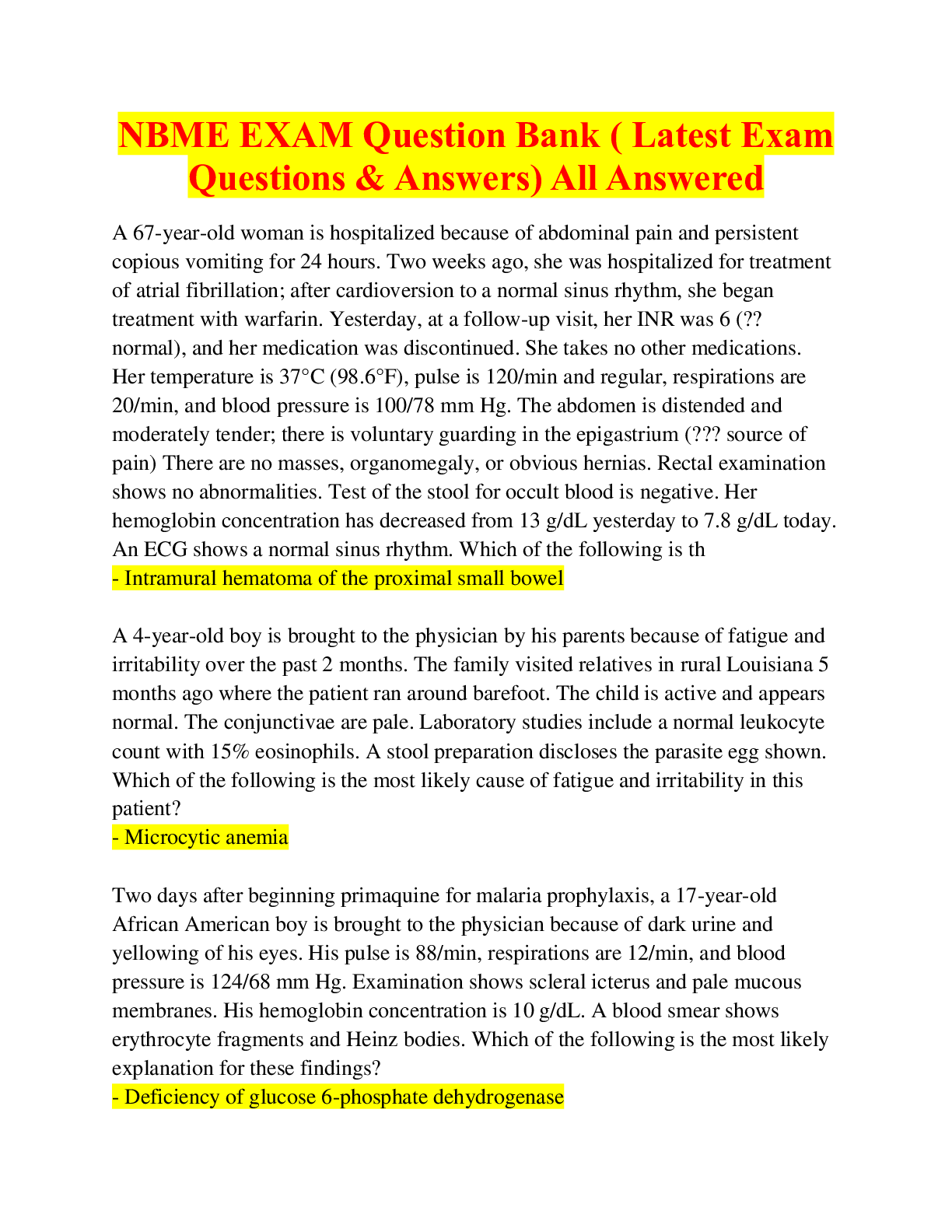
Also available in bundle (1)

BUNDLE: NBME FULL SOLUTION PACK(Bundled exams with complete solutions) Latest Exams Answered
BUNDLE: NBME FULL SOLUTION PACK(Bundled exams with complete solutions) Latest Exams Answered
By PROF 4 months ago
$35.5
10
Reviews( 0 )
Document information
Connected school, study & course
About the document
Uploaded On
Dec 28, 2023
Number of pages
241
Written in
Additional information
This document has been written for:
Uploaded
Dec 28, 2023
Downloads
0
Views
21






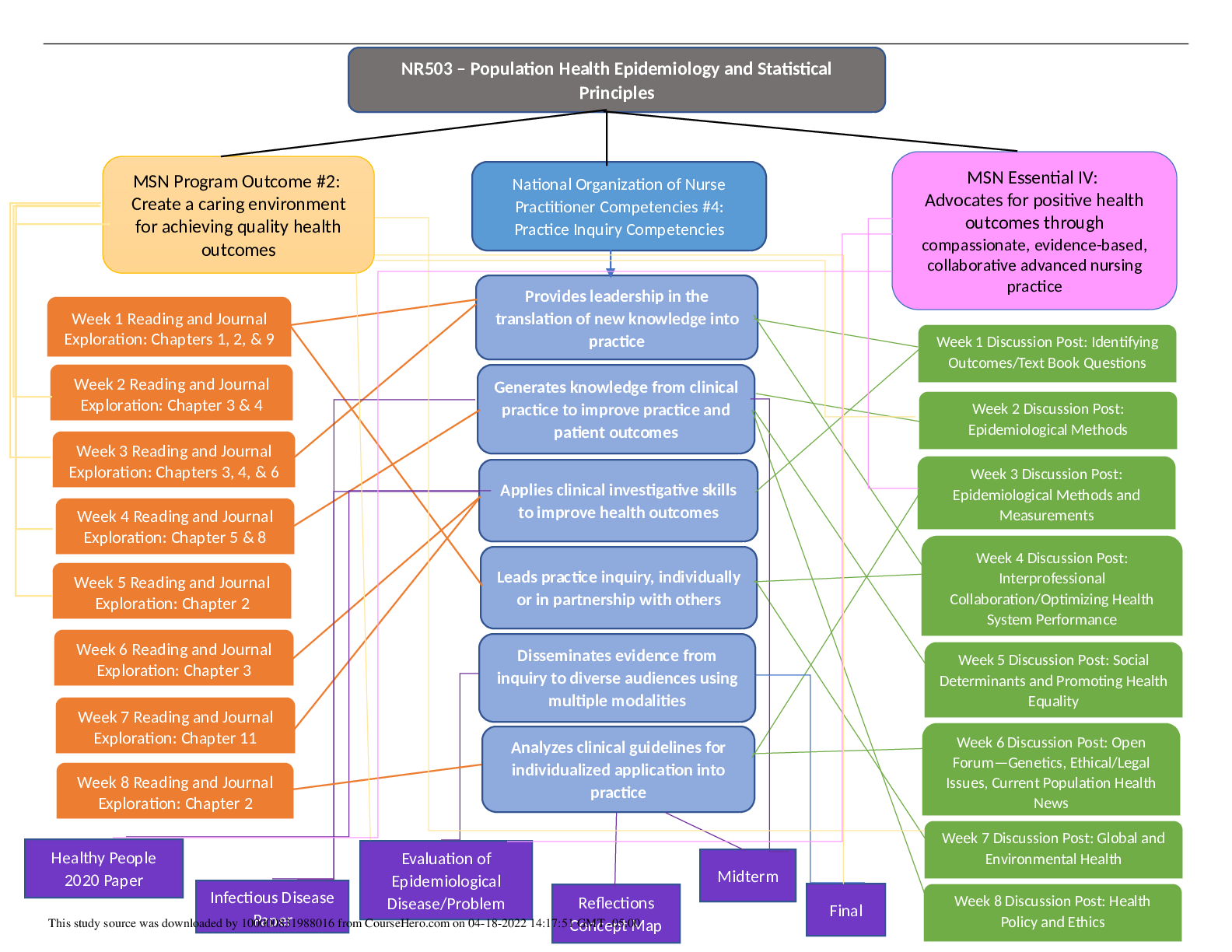

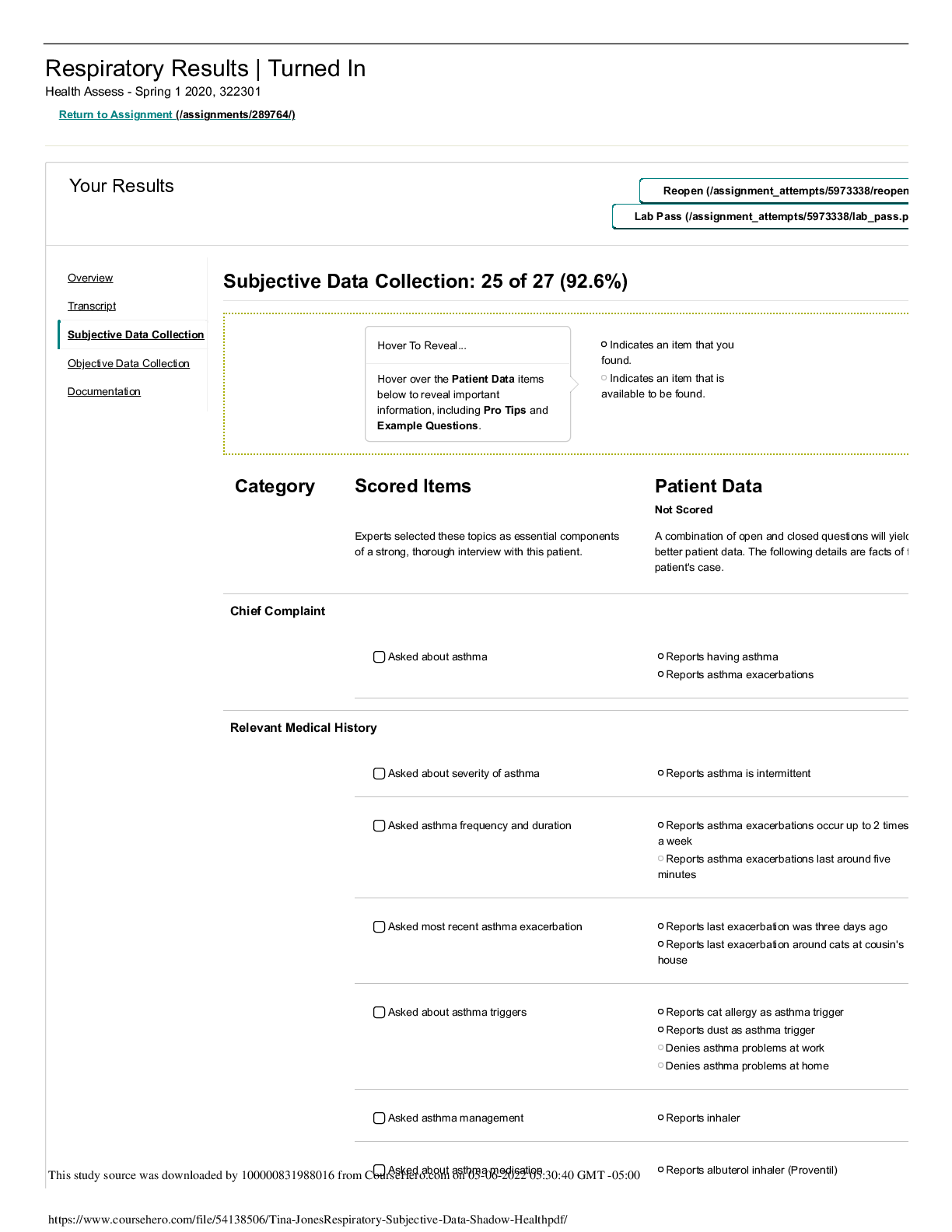




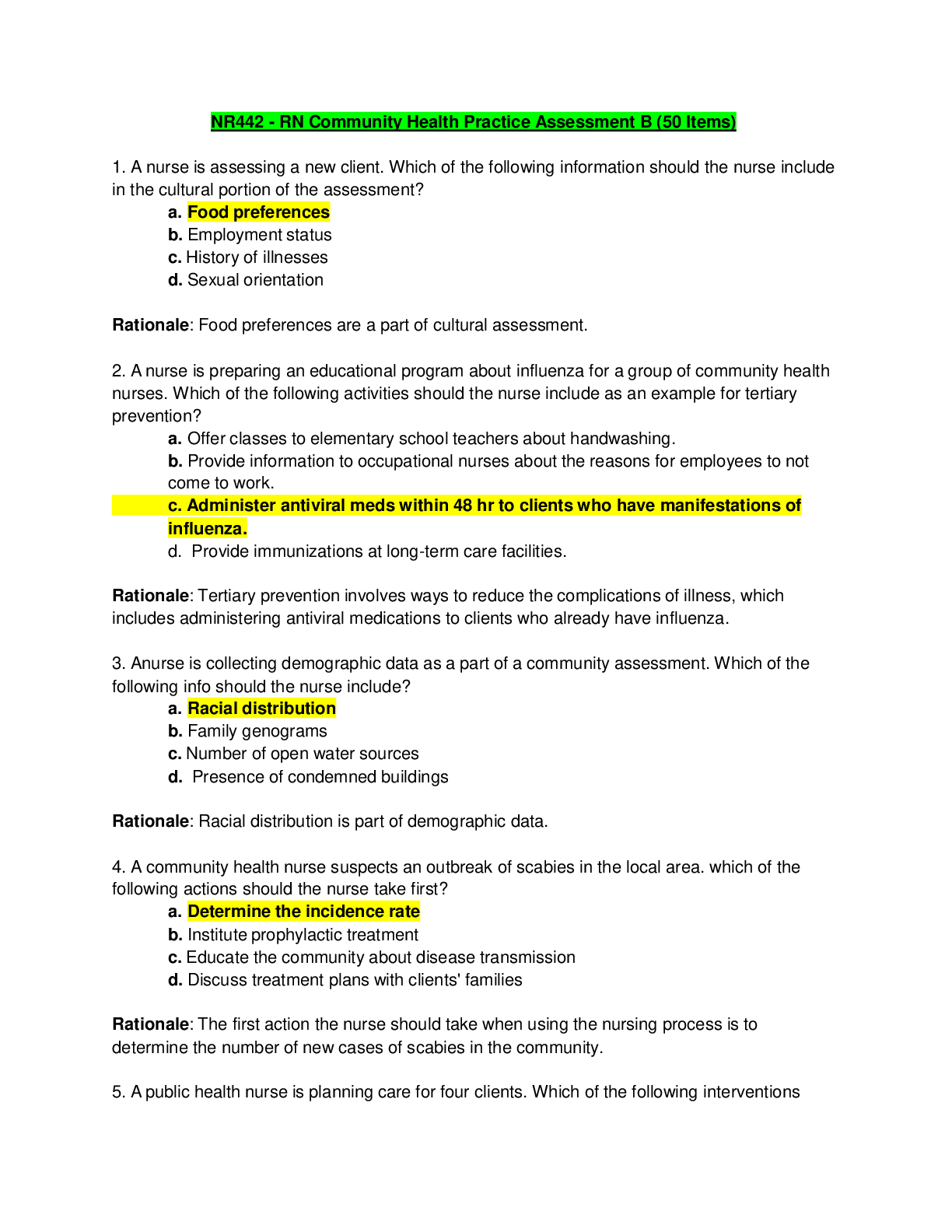


.png)
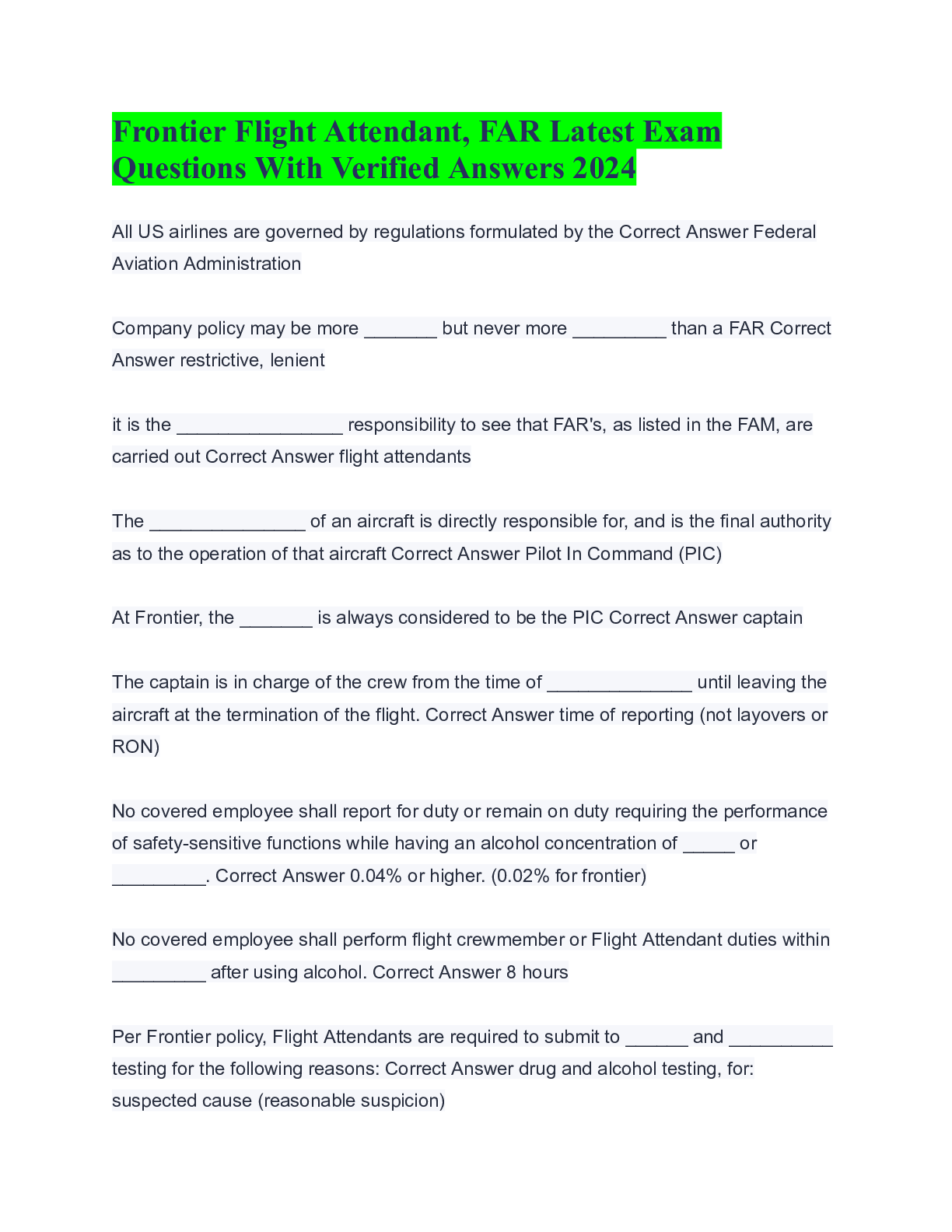
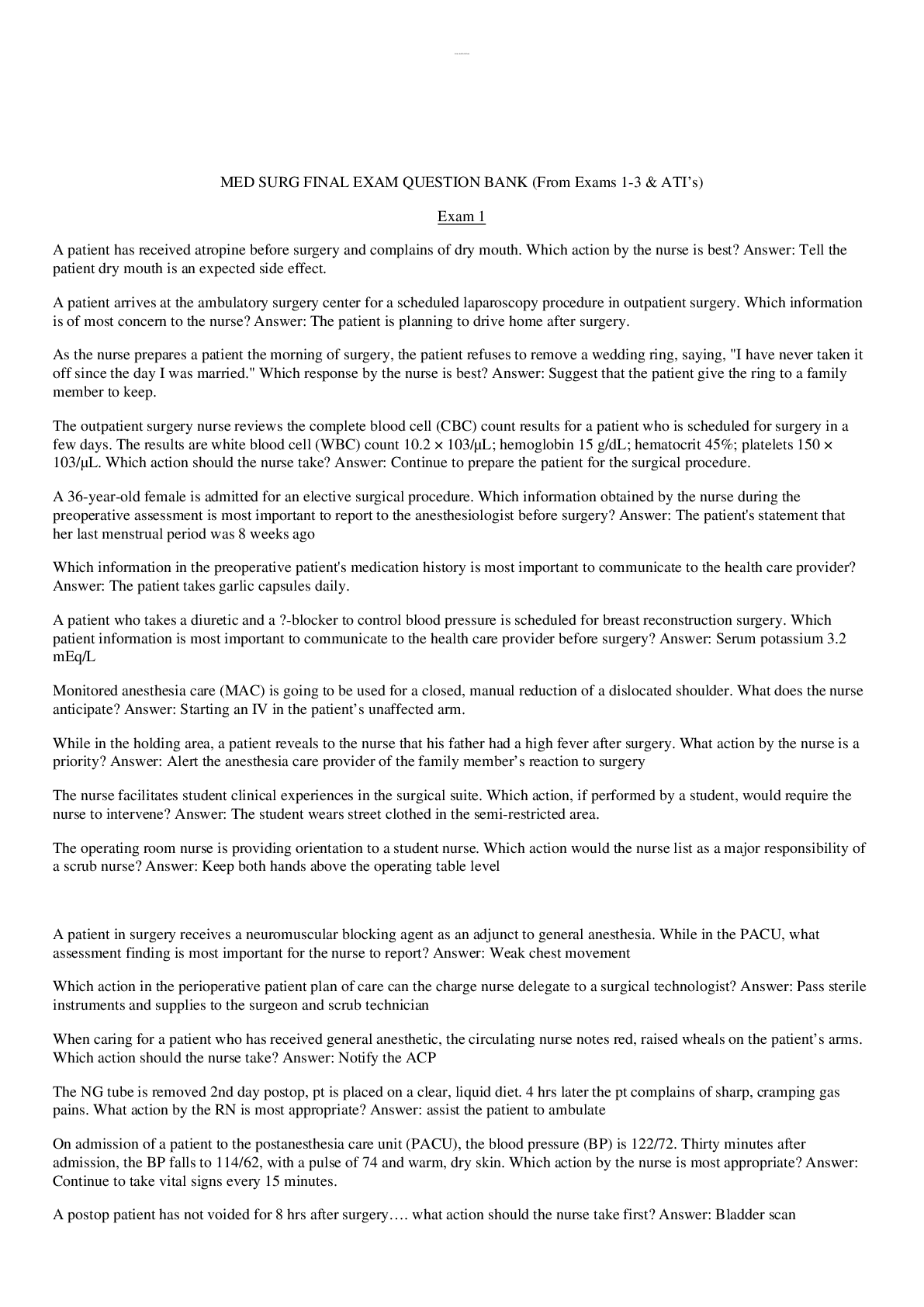
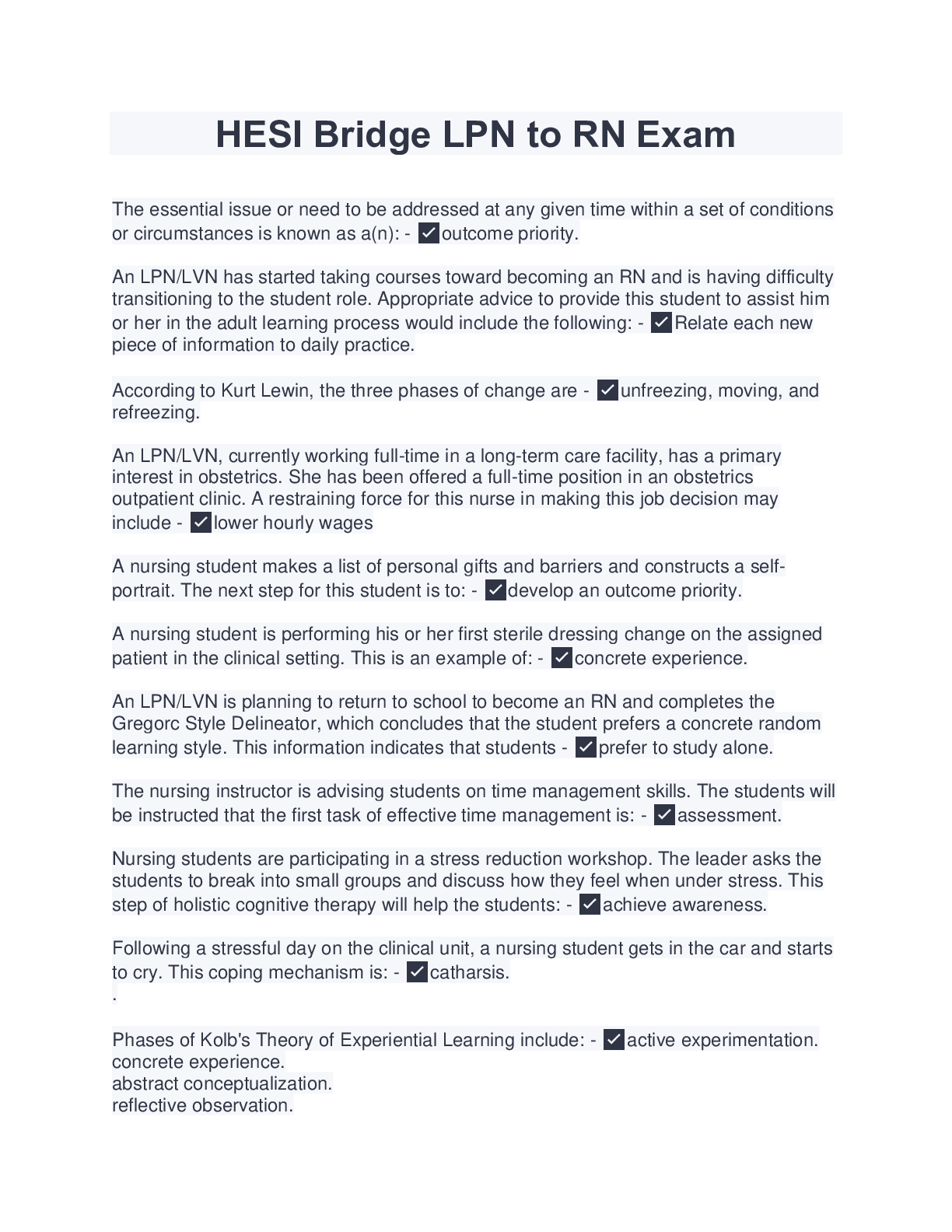


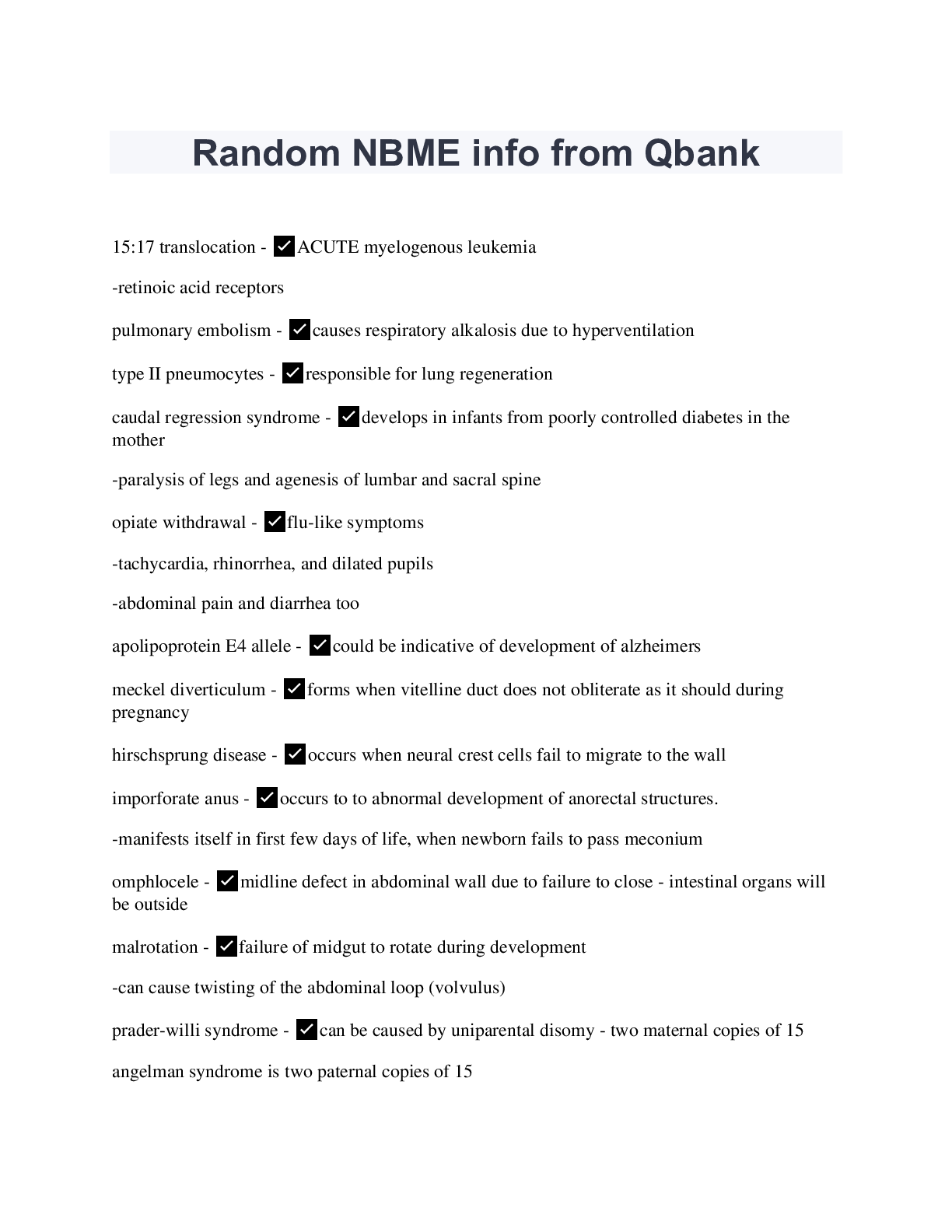
.png)
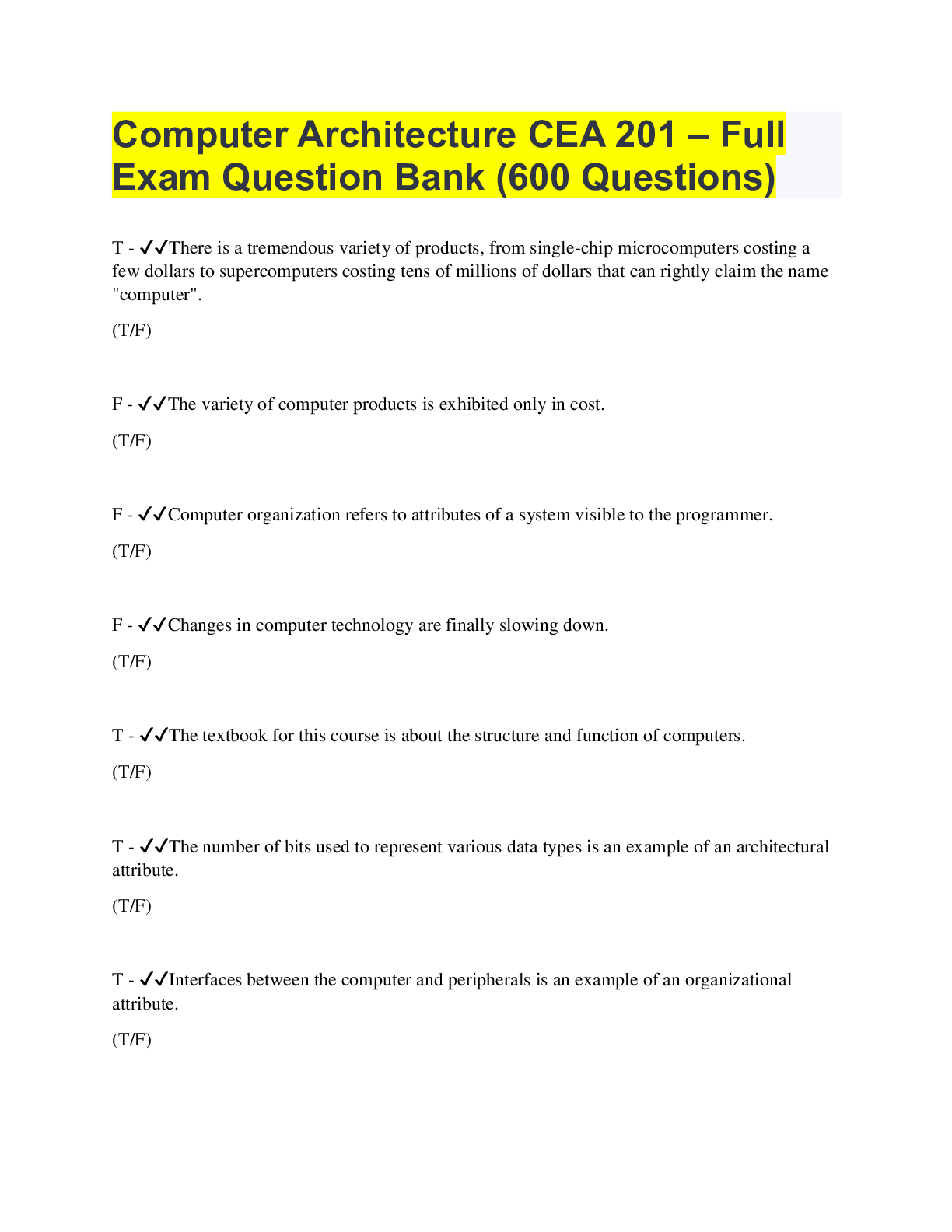

.png)
